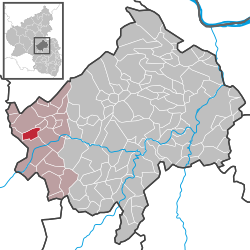Oberhausen bei Kirn
| Oberhausen bei Kirn | ||
|---|---|---|
|
||
| Coordinates: 49°48′31″N 07°27′02″E / 49.80861°N 7.45056°ECoordinates: 49°48′31″N 07°27′02″E / 49.80861°N 7.45056°E | ||
| Country | Germany | |
| State | Rhineland-Palatinate | |
| District | Bad Kreuznach | |
| Municipal assoc. | Kirn-Land | |
| Government | ||
| • Mayor | Thomas "TJ" Jung (FW) | |
| Area | ||
| • Total | 4.58 km2 (1.77 sq mi) | |
| Elevation | 400 m (1,300 ft) | |
| Population (2015-12-31) | ||
| • Total | 902 | |
| • Density | 200/km2 (510/sq mi) | |
| Time zone | CET/CEST (UTC+1/+2) | |
| Postal codes | 55606 | |
| Dialling codes | 06752 | |
| Vehicle registration | KH | |
Oberhausen bei Kirn is an Ortsgemeinde – a municipality belonging to a Verbandsgemeinde, a kind of collective municipality – in the Bad Kreuznach district in Rhineland-Palatinate, Germany. It belongs to the Verbandsgemeinde of Kirn-Land, whose seat is in the town of Kirn, although this lies outside the Verbandsgemeinde. Oberhausen bei Kirn is one of two municipalities in the district with the name Oberhausen. The other is Oberhausen an der Nahe.
Oberhausen bei Kirn lies on a high plateau at the edge of the Lützelsoon above Kirn on the River Nahe.
Clockwise from the north, Oberhausen bei Kirn’s neighbours are the municipalities of Hennweiler, Heinzenberg and Hochstetten-Dhaun, the town of Kirn and the municipality of Hahnenbach, all of which likewise lie within the Bad Kreuznach district.
Also belonging to Oberhausen bei Kirn are the outlying homesteads of Itzebacherhof, Königshof and Schloss Wartenstein.
The land that is now Oberhausen’s municipal area was settled very early on. A few archaeological finds at barrows of the so-called “Old Hunsrück-Eifel Culture”, for instance a bronze torc and bronze armrings, are traces of human habitation from the time between 600 and 400 BC. Leading across what is now the municipal area were two important prehistoric roads, of which the so-called Salzstraße (“Salt Road”) linked the upper Nahe region with the Rhine and the other, a road from Kirchberg to Meisenheim, served as a north-south link between the Moselle region and the North Palatine Uplands. Oberhausen’s first documentary mentions are found in documents from 1342 (Obernhusen) and 1346. The latter is a Weistum (cognate with English wisdom, this was a legal pronouncement issued by men learned in law in the Middle Ages and early modern times) in which the court Schöffe (roughly “lay jurist”) “Hermann von Obirnhusen” is named as a member of the Hennweiler court’s council of Schöffen. Oberhausen then belonged to the Vogtei of Heinzenberg, a mediaeval jurisdictional and administrative region formed of the villages of Hennweiler, Oberhausen, Guntzelnberg, Rode and Heinzenberg and the Eigener Hof (an estate). Here, the Lords of Heinzenberg, who lived at a castle in the Kellenbach valley, were responsible as Vögte for giving the law and for raising tax revenue. Hennweiler was the “mother village” in this greater municipal area, whereas Oberhausen was, like all the other outlying villages, a “daughter village” or an “expansion settlement”. The Vogtei region was also a parochial region whose mother church was Saint Stephen’s (Stephanuskirche) in Hennweiler. In the Late Middle Ages, Oberhausen became part of the Lordship of Wartenstein and belonged to the Unteramt of Hennweiler. It was then that power passed from the Lords of Heinzenberg, first to Tilmann vom Stein (or Wartenstein), but he died without having fathered any male offspring, and his power eventually passed over time, by marriage into other families of the lower nobility, to other lines. These families who had acquired Tilmann’s holdings and rights in the Lordship of Wartenstein, formed a kind of Ganerbengemeinschaft, a form of condominium, whereby they ruled jointly. In the course of the earlier half of the 16th century, the Lords of Schwarzenberg eventually managed to secure their place as the sole lordship in the Unteramt of Hennweiler, although they had to be mindful that their overlords were still the Counts – later Dukes – of Palatinate-Zweibrücken, who were rightful successors to the Counts of Veldenz. As the village lord, Johann III of Schwarzenberg introduced the Reformation into the parish of Hennweiler/Oberhausen sometime about 1550. Oberhausen formed together with Hennweiler a greater municipal area in the Late Middle Ages that was run as a Markgenossenschaft – a combined municipality with one administration and a single body of law. It was only later that the municipal area was split between the two villages. The villages’ common woodlands were shared out as late as 1769. Beginning in 1798, Oberhausen lay under French rule, as did all the German lands on the Rhine’s left bank. This lasted until the Napoleonic French were driven out in 1814. During this time, Oberhausen belonged to the Mairie (“Mayoralty”) of Kirn in the Arrondissement of Simmern. After the Congress of Vienna had grouped the village into the Kingdom of Prussia, Oberhausen remained with the same mayoralty, although the German word Bürgermeisterei was now used for it. After Kirn was granted town rights in 1857, though, it together with the outlying villages formed a municipal body known as the Landbürgermeisterei Kirn, which was headed by the mayor of Kirn. This “personal union” was dissolved in 1896, whereupon representatives of the rural villages chose their own Bürgermeister (mayor). Ever since, Oberhausen has remained in this municipal league of “Kirn-Land” without interruption, although in the course of administrative restructuring in Rhineland-Palatinate, it ceased to be an Amt in 1969 and became instead the Verbandsgemeinde of Kirn-Land. Over the last few decades, Oberhausen has grown from a mainly agriculturally orientated village into a modern residential community. Since 1953/1954, water has been supplied to the village by the Gruppenwasserwerk Krebsweiler (“Krebsweiler Group Waterworks”). Sewerage was laid between 1956 and 1963, and carries sewage to the treatment plant at Kirn.
...
Wikipedia



